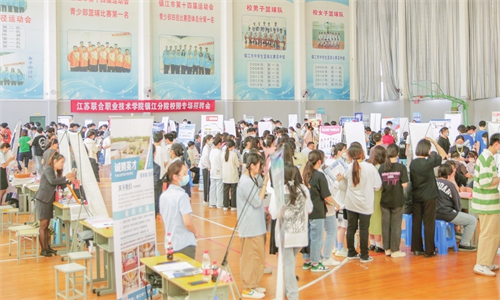
A special campus job fair is held at Zhenjiang Vocational Technical College on June 2, 2022, aiming to boost employment of graduates and facilitate the resumption of work for local companies. Photo: IC
China’s surveyed urban unemployment stood at 5.9 percent in May, a month-on-month decrease of 0.2 percentage points, data from the National Bureau of Statistics (NBS) revealed on Wednesday, representing an overall improved employment landscape, while uncertainties resulting from domestic COVID-19 flare-ups still linger.
From January to May in 2022, 5.29 million new jobs were created in urban areas across the country. The unemployment rate for the nation’s major employed group aged from 25 to 59 stood at 5.1 percent, down 0.2 percentage points from April, showing that the domestic employment situation has improved, Fu Linghui, a spokesperson from the NBS noted at a press conference.
Meanwhile, the surveyed unemployment rate for rural migrant workers decreased 0.4 percentage points to 6.2 percent compared with April. The group is mostly employed in labor-intensive industries such as manufacturing, construction, wholesale and retail work. These sectors are typically populated by private employers and offer relatively poor employment stability. The improved employment for migrant workers also reflected measures to stabilize employment have been effective.
Fu also stressed that the negative impact sparked by the previous domestic outbreak remains ongoing, especially for young people following a reduced recruitment demand from large employers. Young job seekers now tend to apply for more stable positions, which has exacerbated the tension between supply and demand.
In May, the unemployment rate for young people aged 16 to 24 was 18.4 percent, up 0.2 percentage points from the previous month. China's college graduates in 2022 hit a record high of 10.76 million. With the graduation season approaching, the concentration of college graduates entering the labor market may further aggravate employment pressure.
Moving forward, China will continue to implement targeted policies and measures to ease employment pressure by supporting enterprises, stabilizing the labor market, and promoting industrial transformation and upgrading to create more high-quality positions for college graduates, Fu said.
For instance, China has been ramping up efforts to promote the development of its vocational education system as a means to expand the nation's employment channels while cultivating more targeted talent for emerging high-tech industries.
The revised Vocational Education Law came into force on May 1, which clearly defines that the vocational education in China is equally important as general education and encourages the development of a variety of forms of vocational education. Multiple cities and provinces across the nation have come up with relevant supporting measures following the implementation of the law.
China has established the world's largest vocational education system and has a total of 11,300 vocational education schools with more than 30 million students, data from the Ministry of Education showed.
Global Times

